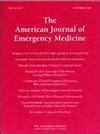Effects of coagulopathy and its correction on time to source control and clinical outcomes in patients with sepsis
IF 2.2
3区 医学
Q1 EMERGENCY MEDICINE
引用次数: 0
Abstract
Objectives
Radiological intervention is often required for infection source control in sepsis, and correcting coagulopathy prior to procedures with bleeding risk is recommended. This study aimed to evaluate the impacts of correcting coagulopathy on time to intervention and on 28-day mortality in patients with sepsis undergoing abdominal radiological interventions.
Methods
This retrospective cohort study utilized prospectively collected sepsis registry from the emergency department of a tertiary hospital. Adult patients with sepsis or septic shock who underwent abdominal radiological intervention between January 2011 and December 2020 were included. Coagulopathy was defined as PT-INR > 1.5 or platelet count <50,000/μL. The primary outcome was 28-day mortality, and secondary outcome included major bleeding complications, requiring transfusion, embolization or surgery. Multivariable logistic regression was performed to identify independent associations.
Results
Among the 597 patients analyzed, 161 (27.0 %) had coagulopathy. Among these, 55 (34.2 %) underwent correction prior to intervention. Patients who underwent correction had a significantly longer median time to intervention (15.3 vs. 6.0 h, P < 0.001) and higher 28-day mortality (41.8 % vs. 22.6 %, P = 0.02), but no reduction in major bleeding complications was achieved. In multivariable analysis, coagulopathy correction associated independently with a higher 28-day mortality rate (OR, 2.52; 95 % CI, 1.13–5.66, P = 0.03) but not with the incidence of major bleeding complications (OR 1.80; 95 % CI, 0.83–3.90, P = 0.13).
Conclusions
In septic patients with coagulopathy undergoing abdominal radiological intervention, coagulopathy correction correlated with delayed source control and increased 28-day mortality, without reducing major bleeding complications.
脓毒症患者凝血功能障碍及其纠正对时间源头控制和临床结局的影响
目的败血症感染源控制通常需要影像学干预,建议在有出血风险的手术前纠正凝血功能障碍。本研究旨在评估纠正凝血功能障碍对接受腹部放射治疗的脓毒症患者干预时间和28天死亡率的影响。方法回顾性队列研究采用前瞻性收集的某三级医院急诊科败血症登记资料。纳入2011年1月至2020年12月期间接受腹部放射干预的脓毒症或脓毒性休克成年患者。凝血功能障碍定义为PT-INR;1.5或血小板计数<;50,000/μL。主要结局是28天死亡率,次要结局包括主要出血并发症,需要输血、栓塞或手术。采用多变量逻辑回归来确定独立关联。结果597例患者中,161例(27.0%)有凝血功能障碍。其中55例(34.2%)在干预前接受了矫正。接受矫正的患者到干预的中位时间明显更长(15.3 vs. 6.0 h, P <;0.001)和更高的28天死亡率(41.8%对22.6%,P = 0.02),但没有减少主要出血并发症。在多变量分析中,凝血功能矫正与较高的28天死亡率独立相关(OR, 2.52;95% CI, 1.13-5.66, P = 0.03),但与大出血并发症的发生率无关(OR 1.80;95% ci, 0.83-3.90, p = 0.13)。结论在接受腹部放射治疗的脓毒症凝血功能障碍患者中,凝血功能障碍纠正与延迟源控制和28天死亡率升高相关,但未减少主要出血并发症。
本文章由计算机程序翻译,如有差异,请以英文原文为准。
求助全文
约1分钟内获得全文
求助全文
来源期刊
CiteScore
6.00
自引率
5.60%
发文量
730
审稿时长
42 days
期刊介绍:
A distinctive blend of practicality and scholarliness makes the American Journal of Emergency Medicine a key source for information on emergency medical care. Covering all activities concerned with emergency medicine, it is the journal to turn to for information to help increase the ability to understand, recognize and treat emergency conditions. Issues contain clinical articles, case reports, review articles, editorials, international notes, book reviews and more.

 求助内容:
求助内容: 应助结果提醒方式:
应助结果提醒方式:


